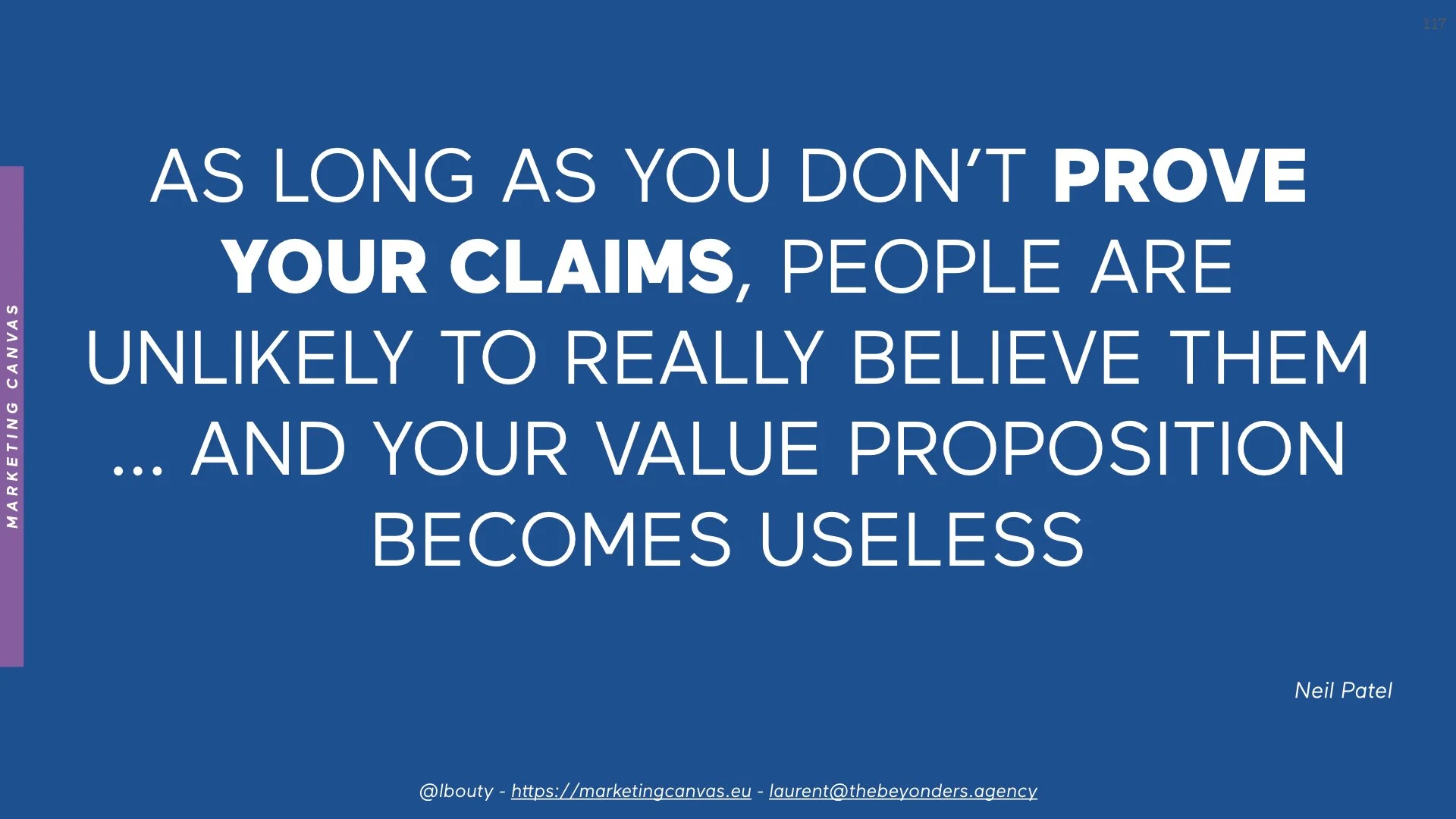Last update: 8/11/2024
In a nutshell
The Proofs sub-dimension in the Marketing Canvas focuses on the evidence and validation that support your value proposition. Proofs help build trust and credibility by demonstrating how your offering delivers on its promises, reducing customer uncertainty and reinforcing your brand’s reputation. This evidence may include testimonials, case studies, certifications, third-party endorsements, and other trust-building tools.
For example, Green Clean might use certifications like "Certified Organic" or endorsements from environmental organizations to validate its claims of sustainability and safety, reassuring customers of its commitment to quality and eco-conscious practices.
Introduction
The Proofs sub-dimension is a vital element of the Value Proposition category in the Marketing Canvas. It addresses the need to substantiate your claims with clear and credible evidence. In an age of increasing skepticism, especially around sustainability claims, providing proof is critical to gaining customer trust, avoiding greenwashing, and reinforcing your brand's reputation.
Proofs help bridge the gap between what a brand promises and what customers believe, ensuring alignment and confidence in your value proposition.
What are proofs?
Proofs are the tangible and credible elements that validate your value proposition, providing customers with the confidence to trust and invest in your offering. These can include:
Operational Context: Demonstrations, examples, or case studies that show your value proposition in action.
Clarification Tools: Detailed explanations, technical specifications, or visual aids that reassure customers about your product or service.
Third-Party Endorsements: Recognized certifications, awards, or endorsements from trusted authorities.
Brand Reputation: References to your brand’s history, achievements, or well-known attributes.
Greenwashing Avoidance: Ensuring that your claims are transparent, accurate, and verifiable.
For instance, Green Clean might showcase customer testimonials, certifications like “EcoCert,” and its long-standing reputation for sustainable innovation to provide robust proof of its eco-friendly claims.
Laurent Bouty - Marketing Canvas Method - Proofs
Proofs: an in-depth perspective
To effectively reinforce your value proposition, your proofs must:
Show Operational Relevance: Provide real-world examples or demonstrations of how your product delivers value.
Reassure Through Clarity: Offer clear explanations or visualizations that address customer concerns.
Leverage Trusted Endorsements: Highlight third-party validations or certifications that strengthen credibility.
Reference Brand Reputation: Connect your value proposition to widely acknowledged elements of your brand’s history or achievements.
Maintain Integrity: Ensure your claims are truthful, avoiding exaggeration or greenwashing.
For example:
Operational Context: Green Clean shares a case study showing how its products helped a customer reduce household toxins by 80%.
Third-Party Endorsements: Certifications like “Leaping Bunny” verify its cruelty-free claims.
Reputation: Green Clean highlights its recognition as a leader in sustainable cleaning solutions.
Translating proofs into action
Providing proof requires an intentional strategy to communicate and display evidence across all customer touchpoints. From marketing materials to customer service, every interaction should reinforce your value proposition with credible and relevant proof points.
Questions to consider:
Have you demonstrated your value proposition in an operational context that customers can easily relate to?
Have you clarified how your value proposition works to reassure potential customers?
Are your claims backed by trusted third-party endorsements?
Do you reference widely acknowledged elements of your brand’s reputation to reinforce your value proposition?
Are you transparent in your claims, ensuring you avoid any perception of greenwashing?
Statements for self-assessment
For a comprehensive evaluation of your understanding and application of the Proofs concept, rate your agreement with the following statements on a scale from -3 (completely disagree) to +3 (completely agree):
You have presented your value proposition in an operational context that makes it possible to see the promised benefit(s).
You have provided elements to clarify exactly how the value proposition operates and reassure the customer.
Your value proposition is supported by means of a recognized third party: i.e., a celebrity ambassador, a label, or other trusted sources.
Your value proposition has made a direct reference to a widely acknowledged element of your brand's reputation.
Your value proposition avoids any form of Greenwashing.
Interpretation of the scores
Negative scores (-1 to -3): Negative scores indicate a lack of sufficient or credible proof to support your value proposition. Customers may be skeptical of your claims, leading to reduced trust and missed opportunities to build loyalty. Immediate steps are needed to integrate credible and transparent evidence into your messaging.
A score of zero (0): A neutral score reflects uncertainty or incomplete application of proof elements. While you may provide some evidence, it is not compelling or consistent enough to fully reassure customers. Further development of proof strategies is necessary to strengthen customer trust and confidence.
Positive scores (+1 to +3): Positive scores suggest that your value proposition is well-supported by clear, credible, and impactful proof elements. Your evidence reassures customers, leverages third-party endorsements, aligns with your brand’s reputation, and avoids greenwashing. This strengthens customer trust and reinforces your value proposition.
Case study: Green Clean’s proofs
Misaligned understanding (-3, -2, -1): Green Clean fails to provide sufficient proof to support its claims, relying only on vague or generic statements. Without tangible evidence, such as certifications or case studies, customers are left skeptical of its eco-friendly promises, weakening trust and reducing purchase intent.
Surface understanding (0): Green Clean offers some proof, such as basic product descriptions or minimal certifications, but lacks consistency or depth. Customers may perceive the brand as credible but not fully reassured, limiting the impact of its value proposition.
Deep understanding (+1, +2, +3): Green Clean provides robust proof points, including certifications like “EcoCert,” testimonials from satisfied customers, and endorsements from environmental organizations. These elements demonstrate operational relevance, clarify its value proposition, and highlight the brand’s reputation as a sustainability leader, building strong trust and loyalty.
Conclusion
The Proofs sub-dimension is essential for building trust and credibility in your value proposition. By demonstrating your claims through operational context, third-party endorsements, and references to your brand’s reputation, you reassure customers and strengthen their confidence in your offering. Transparency and honesty are critical to avoiding greenwashing and maintaining integrity, ensuring that your proofs reinforce long-term loyalty and advocacy.
Sources
Neil Patel, Dominate your Market, https://neilpatel.com/blog/dominate-your-market/
HubSpot, Principles of Persuasion, https://blog.hubspot.com/sales/cialdini-principles-of-persuasion
More on the Marketing Canvas
Marketing Canvas by Laurent Bouty



































